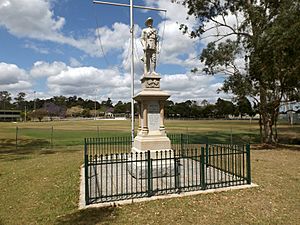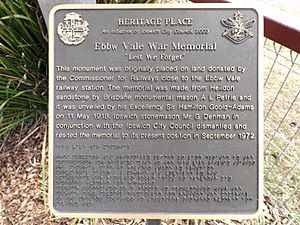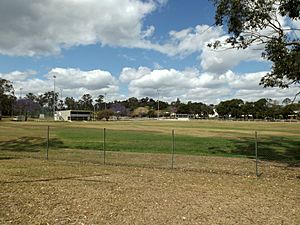Ebbw Vale Memorial Park facts for kids
Quick facts for kids Ebbw Vale Memorial Park |
|
|---|---|

War Memorial, 2015
|
|
| Location | Brisbane Road, Ebbw Vale, City of Ipswich, Queensland, Australia |
| Design period | 1870s - 1890s (late 19th century) |
| Built | c. 1892 - |
| Official name: Ebbw Vale Memorial Park | |
| Type | state heritage (built) |
| Designated | 17 May 2004 |
| Reference no. | 602433 |
| Significant period | c. 1892 -ongoing (fabric, historical use). 1912-1997 (historical, St Helens Soccer Club) |
| Significant components | clubroom/s / clubhouse, sports field/oval/playing field, memorial - soldier statue, sports facilities |
| Lua error in Module:Location_map at line 420: attempt to index field 'wikibase' (a nil value). | |
Ebbw Vale Memorial Park is a special sports park in Ebbw Vale, Queensland. It's located on Brisbane Road in the City of Ipswich, Queensland, Australia. This park is so important that it's listed on the Queensland Heritage Register since May 17, 2004. People have been playing sports here since around 1892!
Contents
The Park's Early Days: A Soccer Story
Ebbw Vale Memorial Park was first known as the Whitwood ground. Back in the early 1890s, the owners of the Whitwood Colliery (a coal mine) let their workers use this land. It became a football ground where miners could play. Soccer has been played here ever since, along with other fun sports.
How Soccer Became a Popular Sport
Football, in its many forms, is a very old game. People played it in Britain for hundreds of years, but the rules were often different everywhere. In 1815, the first written rules for football were made. Then, in 1863, the Football Association was created in Britain. This is when the two main types of football, Rugby and Association football (which we now call soccer), were officially defined.
The word "soccer" actually came from "assoc," which was short for "Association football." This happened in the 1880s.
Soccer Comes to Queensland
Many people from Britain, where football was very popular, moved to Queensland and Ipswich during this time. Miners from England and Wales especially loved the game. Also, workers started getting more free time, like a half-day off on Saturdays. This extra time helped team sports like football become even more popular.
In Queensland, the Anglo-Queensland Football Association started in Brisbane in May 1884. Teams from Brisbane played regular matches. The first soccer game in Ipswich was played on June 26, 1886. Ipswich teams joined the Association in 1887. By the 1890s, soccer was a big deal in Queensland, with strong teams in places like Maryborough and Rockhampton.
The Whitwood Ground and St Helen's
The land for Ebbw Vale Memorial Park was bought by the Stafford brothers in the 1890s. They owned the Whitwood Colliery. Many coal mines had their own football teams made up of miners.
The first soccer game at the Whitwood ground that was written about in the newspaper happened on July 5, 1892. But people had been playing there for a while before that! The home team was a mix of players from local teams like the Bush Rats, Dinmore, and Whitwood.
By 1893, the Whitwood ground was also called St Helen's. This name was later used for the football team itself. The nearby railway station was even called St Helen's for a short time before it became Ebbw Vale. Ebbw Vale is a town in Wales, and it was also the name of an early coal mine in the area.
Community Spirit and Ownership Changes
Over the years, the local community took care of the field. Volunteers, sometimes from the same families for generations, helped run and maintain the park. Players even used a group of trees for changing clothes before a proper clubhouse was built!
In 1924, the Moreton Shire Council bought the land. However, the mining rights for the coal deep underground still belonged to the colliery.
A Golden Era for St Helen's Soccer
During the 1940s, many players joined the defense forces, but the St Helen's club kept going. After World War II, the club had a "golden era" because soccer was super popular in Ipswich. Matches between the four main local teams—Saint Helen's, Blackstone Rovers, Bundamba Rangers, and the Dinmore Bushrats—were very exciting.
St Helen's was a very successful club with lots of fans and amazing players. Some players, like Lance Petie, Duncan McKenna, and Chas Matters, played for Queensland. Even more incredibly, Alan "Oscar" Pitcairn, Gordon "Bunny" Nunn, Col Kitching, Cliff Sander, and Brian Vogler all played for Australia! Sander, Vogler, and Kitching even represented Australia in the 1956 Melbourne Olympics team. The year 1956 was a huge year for St Helen's, as they won all the major trophies!
Changes and New Beginnings
In the 1960s, soccer in Queensland became more professional. Top players started moving to bigger clubs in Brisbane. This meant teams like St Helen's lost some of their best players. Over time, different local clubs merged. In 1966, Dinmore and Redbank merged, and then this new club joined St Helen's to form St Helen's United.
In 1969, a special war memorial was moved to the park from near the Ebbw Vale railway station. This statue of a "Digger" (an Australian soldier) was made by Andrew Lang Petrie and was first shown to the public on May 11, 1918. It honors the brave people from the area who served in World War I. It even includes the names of some soccer team members!
Ebbw Vale became a suburb of Ipswich in 1949. In 1971, the City of Ipswich Council officially owned the park. It continued to be leased to the sports club. In 1997, St Helen's merged with Coalstars Soccer Club to create the Ipswich Knights. Today, the Ebbw Vale field is often used for women's and junior matches.
This park has always been a place for soccer, but it has also hosted cricket, baseball, softball, and touch football. It's also a gathering spot for the community, used for Christmas events, Australia Day, and Anzac Day breakfasts. Some families now have their fourth generation of players enjoying soccer on this historic field!
What Does Ebbw Vale Memorial Park Look Like?
Ebbw Vale is a small suburb, and this soccer park takes up a big part of the local area.
The park has two main playing fields. The original soccer field faces Brisbane Road. The second field, at the back of the park, is used for cricket, baseball, softball, touch football, and other community events.
Park Facilities
Between the two fields, you'll find a car park and a two-story brick clubhouse. The clubhouse has a sloped roof and big windows upstairs that look out over the main soccer field. There are also some spectator stands, a viewing box, a small canteen, and a concrete toilet block. You'll also see a metal storage shed and a recreation area with a shelter, picnic tables, and benches.
The War Memorial
Another very important part of the park is the war memorial. It stands at the corner of Brisbane Road and Jordan Street. It has a square granite base that holds up a white Helidon sandstone pedestal. On top of this is a life-sized statue of a Digger in his marching uniform, standing above crossed British and Australian flags.
Brown sandstone pillars with fancy Corinthian tops separate marble plaques on each side of the pedestal. These plaques proudly display the names of 22 volunteers from the district who served in the war.
Why Ebbw Vale Memorial Park is Special
Ebbw Vale Memorial Park was added to the Queensland Heritage Register on May 17, 2004, because it meets several important criteria.
A Link to Queensland's History
This park is important because it shows how Queensland's history developed. The ground was first used for football and cricket by coal miners in the late 1800s. Soccer became a big sport in Ipswich because of the coal mining industry and its connections to places like Yorkshire and Wales, where mine football teams were common.
The Ebbw Vale field is a key part of how soccer grew in Queensland. It was one of the first "pit fields" (fields used by miners) and later became home to a very successful club that produced many state, national, and even Olympic players in the mid-1900s.
A Rare and Unique Place
Ebbw Vale Memorial Park is special because it's one of the few 19th-century soccer grounds in Queensland that has been used continuously for soccer. This means people have been playing soccer here without stopping for over a hundred years!
A Place for Community and Connection
This park has a strong connection with the local community. For generations, volunteers have looked after the ground, coached teams, and played here. The park is a great example of continuous volunteer service and is a central place for the community to gather and have fun.



